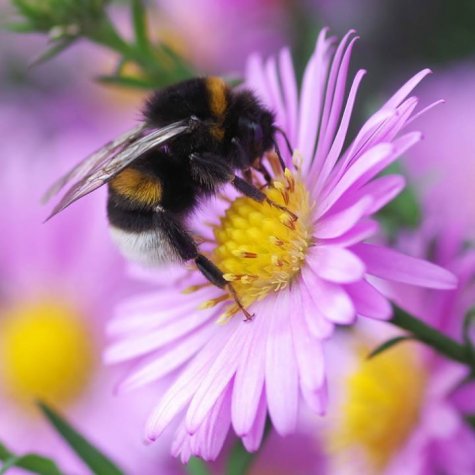Year of the Bumblebees
2014
What threatens bumblebees?
Text: Eneli Viik
Photo: Inga Ilves
Translation: Liis
White-tailed bumblebee, Bombus lucorum
Already since spring we have been introducing bumblebees in Looduskalender, and invited you to observe and photograph these wonderful insects. But it is not just for pleasure, because ever more evidence has accumulated showing that the state of bumblebees has become worse in Europe, North America and Asia, and it is necessary to find out how these important pollinators do here in Estonia. Concern has grown about adequate pollination of both cultivated and wild plants. A single reason for the worsened state is difficult to pinpoint; evidently it is influenced by several factors together.
The largest threat is considered to be the increased intensification of agriculture combined with changes in land use. The result is a fragmentation of habitats, disappearance of suitable living and nesting places, loss of food resources and an increased use of pesticides.
Favourable wintering conditions and spring weather are vital for all female bumble bees but climate changes make their life more difficult. Much damage is done by a changeable winter or a protracted cold and rainy spring when flowers are destroyed. The previous summer or spring of insects and plants also has an effect. For instance in a rainy summer the high soil water level will not allow soil-living bumblebees to nest.
Bumblebees are also plagued by parasites – for instance mites, the larvae of some butterflies and two-wings, nematodes, cuckoo bumblebees as well as several diseases. The spread of diseases is facilitated by the trade with bumblebee colonies: bumblebees are used for the pollination of greenhouse plants.
Bumblebees are also threatened by alien species among plants and other competing pollinators. In places also predators feeding on bumblebees and their nest contents (small mammals, birds, mink, fox) are disproportionately numerous.
According to the Estonian Nature Conservation Act, 18 “true” bumblebee species belong to the IIIrd conservation category. In addition recently a red list was set up of the 68 bumblebee species in Europe (“true” as well as cuckoo bumblebees). Which of these species are endangered and if so, to which danger category they belong, was charted in the process. 24% of the European bumblebee species was found to be threatened. In addition, 46 % of the 68 bumblebee species have decreasing populations, 25% stable, and 13 % increasing populations according to the investigation.
Of the bumblebee species occurring in Estonia all cuckoo and 17 of the “true” bumblebee species are common in Europe according to the study; 3 species are threatened (great yellow bumblebee (Bombus distinguendus) and moss carder bee (Bombus muscorum)and Bombus confusus) and 1 species near threatened (Bombus laesus). The population trends however show differently: of our cuckoo and true bumblebees, 12 species have decreasing populations, 7 species stable, 7 species increasing and 1 species unknown population trends.
The red list of European species is here.
Take part in bumblebee observations and help to collect new knowledge about the distribution of bumblebees in Estonia!
Bumblebee observation guide and form: LINK
Bumblebee identification forms: LINK
Bumblebee web questionnaire form: LINK
Join the “Meie kimalased – Our bumblebees“ group on Facebook: LINK









